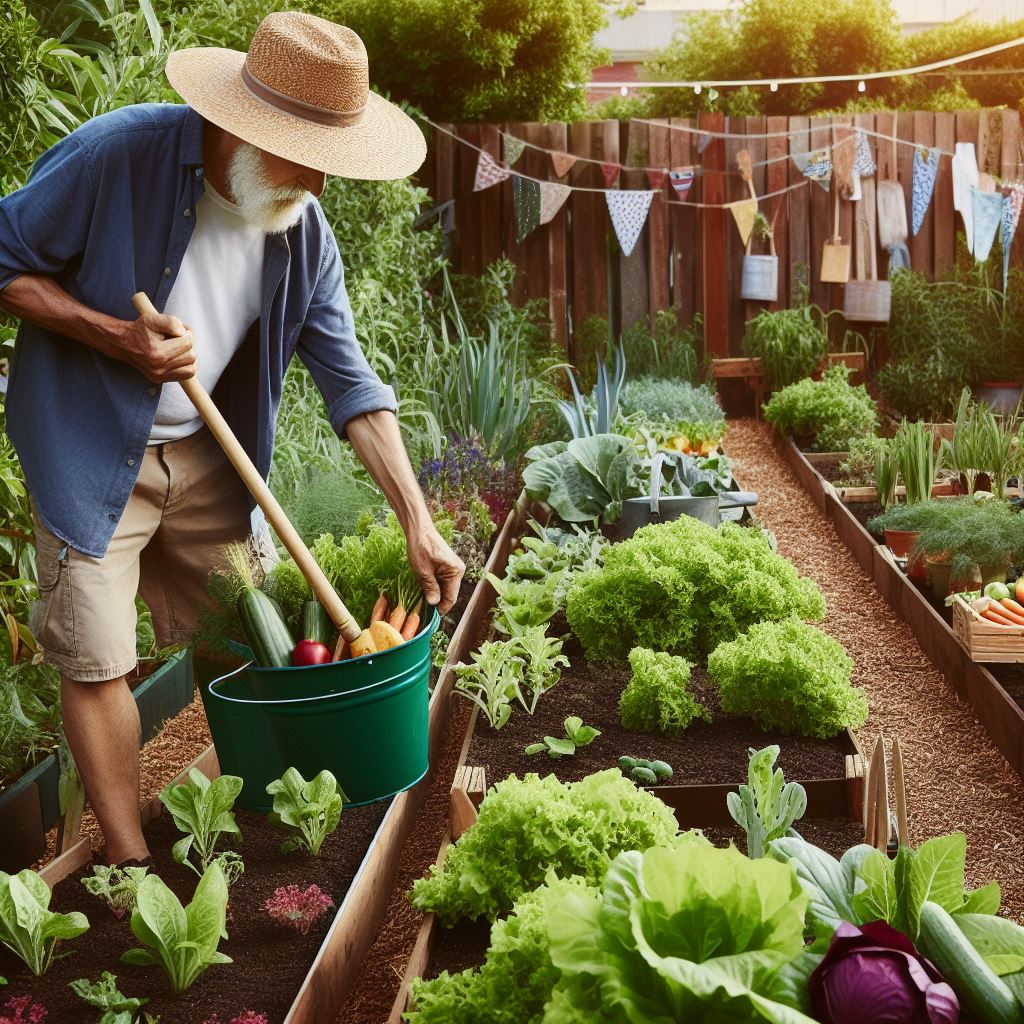Introduction to Community Supported Agriculture (CSA)
Unlocking the potential of sustainable and local food systems, Community Supported Agriculture (CSA) pioneers a direct farmer-consumer connection.
Embracing CSA signifies a commitment to fostering a resilient and eco-conscious community.
CSA, defined as a mutual pact between farmers and consumers, nurtures a local, seasonal, and sustainable food supply chain.
It transcends a mere transaction; it’s a shared responsibility for cultivating a healthier, more connected society.
Why is CSA pivotal? It champions the reduction of food miles, slashing the carbon footprint associated with conventional supply chains.
By fortifying the ties between farmers and consumers, CSA ensures fair compensation for producers and access to fresh, high-quality produce for consumers.
The beauty of CSA lies in its symbiotic nature, where community members actively participate in the agricultural process, sharing both the risks and rewards.
This collaborative approach not only fosters a sense of belonging but also bolsters local economies, creating a ripple effect of positive change.
In essence, CSA is the cornerstone of a grassroots movement towards a sustainable, locally driven food revolution.
As we delve deeper into the CSA landscape, the sections ahead will illuminate its facets, unraveling the potential it holds for shaping a more resilient and conscious future.
Benefits of Joining a CSA
Community Supported Agriculture (CSA) programs offer numerous advantages for individuals and communities alike.
By participating in a CSA, you can enjoy a range of benefits that extend beyond access to fresh and seasonal produce.
Let’s explore some of these benefits:
Access to Fresh and Seasonal Produce
When you join a CSA, you gain direct access to high-quality, fresh, and seasonal produce.
By bypassing the traditional retail channels, which often involve long transportation times and storage, CSA members receive the harvest at its peak flavor and nutritional value.
This means you get to enjoy the tastiest and healthiest produce available.
Support for Local Farmers and the Local Economy
CSA programs provide vital support to local farmers by securing their income in advance.
By paying for a CSA subscription, you are directly investing in your local farming community.
This support allows farmers to plan and sustain their operations, ensuring their continued presence and contribution to the local economy.
Connection to the Food Source and Farming Community
Joining a CSA allows you to build a meaningful connection to the source of your food.
You become part of a community of people who share a common interest in sustainable agriculture and healthy eating.
By visiting the farm, participating in on-site events, or engaging with farmers, you deepen your understanding of the food production process and develop a deeper appreciation for the hard work involved.
Potential Cost Savings
Participating in a CSA can offer potential cost savings compared to purchasing produce from regular retail channels.
By becoming a member, you often receive a share of the farm’s harvest at a lower cost than the equivalent produce would be sold for individually.
Additionally, CSA members may benefit from special offers, discounts, or bulk purchasing opportunities.
Environmental Benefits of Reduced Transportation and Packaging
Choosing a local CSA reduces the environmental impact associated with food transportation.
By supporting a nearby farm, you minimize the distance your produce travels, resulting in lower carbon emissions.
Additionally, CSA programs often aim to reduce packaging waste by providing items in reusable containers, keeping unnecessary plastic and packaging out of the landfill.
In fact, the benefits of joining a CSA extend far beyond access to fresh and seasonal produce.
By participating in a CSA program, you support local farmers, connect with the food source, potentially save money, and contribute to a more sustainable and environmentally friendly food system.
So why not join a CSA today and experience these wonderful benefits firsthand?
Read: Organic Pest Control: Effective Strategies
How Does CSA Work?
Overview of the CSA model
Community Supported Agriculture (CSA) is a unique and sustainable model that directly connects consumers with local farmers.
It offers a way for people to have a direct role in supporting local agriculture, while at the same time enjoying fresh, seasonal produce.
Subscription-based system
The CSA model operates on a subscription-based system, where individuals or families become shareholders or members of a farm.
Typically, members pay an upfront fee or subscribe to a weekly or monthly box of produce.
Transform Your Agribusiness
Unlock your farm's potential with expert advice tailored to your needs. Get actionable steps that drive real results.
Get StartedShareholders’ commitment and responsibilities
The commitment and responsibilities of shareholders vary depending on the CSA program.
Some require members to work a certain number of hours on the farm, while others simply ask for financial support.
Distribution methods (pickup locations, delivery options)
Distribution methods are an essential aspect of CSA. Most CSAs offer multiple pickup locations in the community, making it convenient for members to collect their shares.
Some even provide home delivery options for an additional fee.
Communication with farmers and engagement opportunities
Effective communication between farmers and shareholders is crucial for the success of a CSA.
Most CSAs have newsletters or email updates that inform members about what crops are in season, upcoming events, and any farm-related news.
Engagement opportunities are also a significant feature of CSAs.
Many CSAs organize farm visits, where members can meet the farmers, learn about sustainable farming practices, and get a hands-on experience.
Some CSAs even offer workshops or cooking classes using the produce from the farm.
Joining a CSA has several benefits. Firstly, it supports local agriculture and ensures that small-scale farmers can sustain their operations.
This, in turn, strengthens local food systems and reduces reliance on industrial agriculture.
CSA members also gain access to fresh, seasonal produce that is harvested at its peak flavor and nutrition.
By receiving a variety of fruits, vegetables, and sometimes other products like eggs or dairy, members can expand their culinary horizons and try new recipes.
Moreover, CSA members often develop a sense of community.
They can interact with other shareholders during pickup times, share recipes and cooking tips, and even create lasting friendships.
CSAs also promote environmental sustainability.
By reducing the distance traveled by food from farm to consumer, CSAs help decrease greenhouse gas emissions and minimize packaging waste.
Additionally, many CSAs practice organic farming methods, thus minimizing the use of synthetic pesticides and fertilizers.
In short, CSA is an innovative and beneficial model that connects consumers with local farmers in a sustainable way.
By supporting CSAs, individuals can contribute to the growth of local agriculture, enjoy fresh and seasonal produce, and foster a sense of community.
So why not give CSA a try and embark on a journey towards a healthier and more sustainable food system?
Read: Root to Stem: Waste-Free Cooking
Choosing the Right CSA
When it comes to selecting the perfect Community Supported Agriculture (CSA) for you, there are several factors to consider.
Here is a comprehensive guide to help you make an informed decision:
Researching local CSA options
- Start by researching the CSA options available in your local area.
- Check online directories, local agriculture organizations, and farmer’s markets for information.
- Consider the proximity of the CSA to your home or workplace for convenience.
Evaluating farmers’ practices and values
- Look into the farmers’ practices and values to ensure they align with your own.
- Find out if they follow organic, sustainable, or regenerative farming methods.
- Consider supporting farmers who prioritize environmental stewardship and animal welfare.
Understanding share options, sizes, and delivery schedules
- Take into account the different share options available.
- Determine if you prefer a full or half share, and if customizable shares are offered.
- Check the delivery schedules and choose one that fits well with your routine.
Consideration of dietary preferences and restrictions
- If you have specific dietary preferences or restrictions, make sure the CSA can accommodate them.
- Inquire about options for vegetarian, vegan, gluten-free, or other specialized diets.
- Verify if the CSA provides allergen information for their produce and products.
Reading testimonials and reviews
- Read testimonials and reviews from current or previous CSA members.
- Look for feedback on the quality and variety of the produce, as well as customer satisfaction.
- Consider reaching out to friends, neighbors, or online communities for personal recommendations.
By carefully considering these factors, you can choose the right CSA that meets your needs and preferences.
Remember, a CSA is not just about acquiring fresh produce; it’s about supporting local farmers and fostering a closer connection to the food you consume.
Read: Artisan Cheeses: Pairing and Recipes

What to Expect as a CSA Member
Seasonal Variability in Produce
- As a CSA member, you can expect a wide variety of fresh produce throughout the year.
- The offerings are dependent on the seasons and what is currently growing on the farm.
- This means that you will experience an ever-changing selection of fruits and vegetables.
Exploring New and Unfamiliar Vegetables
- Being a CSA member provides you with the opportunity to try new and unfamiliar vegetables.
- You may encounter unique varieties that are not commonly found in grocery stores.
- This allows for a culinary adventure and expands your palate.
Dealing with Surplus or Unexpected Challenges
- Sometimes, CSA members may receive an abundance of a particular vegetable due to a successful harvest.
- This surplus can be overwhelming for some, but it presents an opportunity to explore creative recipes and share with friends and neighbors.
- Additionally, unforeseen challenges such as weather conditions may affect crop yields, and members need to be flexible and understanding.
Recipe Resources and Cooking Tips
- CSA farms often provide resources such as recipe suggestions and cooking tips.
- These resources can help you make the most out of your CSA share by providing guidance on how to prepare unfamiliar vegetables.
- You can find online resources, printed recipe cards, or even cooking classes offered by the farm.
Building Relationships with Farmers and Fellow Members
- Being a CSA member goes beyond just receiving fresh produce; it’s about building relationships.
- You’ll have the opportunity to meet and interact with the farmers who grow your food.
- CSA farms often organize community events where members can gather, fostering a sense of camaraderie.
As a CSA member, you can expect to embark on a journey of seasonal variability, culinary exploration, and community building.
Read: Seasonal Eating from Organic Farms
Tips for a Successful CSA Experience
Community Supported Agriculture (CSA) programs are a great way to support local farmers, connect with your community, and enjoy fresh, seasonal produce.
To make the most out of your CSA experience, here are some helpful tips:
Meal planning and proper storage
- Plan your meals in advance to make the most of your CSA produce.
- Store your fruits and vegetables properly to maximize freshness and prevent spoilage.
Sharing and trading surplus produce
- If you have more produce than you can consume, consider sharing it with friends, family, or neighbors.
- You can also explore trading your surplus produce for other items with fellow CSA members.
Exploring preservation methods (canning, freezing, fermenting)
- Learn different preservation techniques like canning, freezing, and fermenting to extend the life of your CSA produce.
- This way, you can enjoy the goodness of your CSA share even during the off-season.
Engaging in community events and farm visits
- Take advantage of the community events and farm visits organized by your CSA program.
- These activities allow you to connect with other members and learn more about the farming practices.
Communicating feedback and suggestions to farmers
- Build a strong relationship with the farmers by providing feedback and suggestions regarding your CSA experience.
- Let them know what you loved, what you would like to see more of, and any concerns you may have.
By following these tips, you can make your CSA experience more rewarding, enjoyable, and beneficial for both you and the farmers.
Potential Drawbacks and Solutions
Financial commitment and upfront payments
Participating in a Community Supported Agriculture (CSA) program requires a financial commitment due to upfront payments.
However, there are solutions to overcome this potential drawback:
- Budgeting: Allocate a portion of your monthly income specifically for CSA payments, treating it as a necessary expense.
- Payment plans: Some CSAs offer installment plans, allowing you to spread out the financial commitment over a period of time.
- Group participation: Consider splitting the cost with family, friends, or neighbors to share the burden of upfront payments.
Limited choice in produce selection
While CSA boxes provide fresh and seasonal produce, the limited choice may be a challenge for some individuals.
Here are some solutions to address this concern:
- Recipe research: Expand your culinary skills by searching for recipes that specifically use the produce in your CSA box.
- Food preservation techniques: Learn various methods such as canning, freezing, and pickling to extend the shelf life of the produce.
- Supplemental farmer’s markets: Visit local farmer’s markets to supplement your CSA box with additional produce of your choice.
Time management for meal planning and cooking
Meal planning and cooking can be time-consuming when utilizing a CSA program.
However, effective time management can provide solutions:
- Preparation ahead of time: Set aside a dedicated day for meal planning, preparation, and chopping vegetables to save time during the week.
- Batch cooking: Cook larger quantities of meals in advance and freeze them for quick and easy weeknight dinners.
- Utilize slow cookers or meal delivery services: These options can help minimize the time spent on meal preparation and cooking.
Addressing concerns about food waste
CSA programs sometimes result in an abundance of produce, raising concerns about potential food waste.
Here are some solutions to mitigate this issue:
- Meal planning: Create a meal plan before your CSA delivery to ensure efficient usage of all the produce.
- Sharing with others: Consider sharing excess produce with neighbors, friends, or local community organizations.
- Preservation techniques: Learn methods such as canning, drying, or fermenting to preserve surplus produce.
Dealing with possible crop failures or poor harvests
CSA programs rely on the success of the farm’s harvest, but there is always a risk of crop failures.
Here are some solutions to address potential disappointments:
- Crop diversification: Choose a CSA program that works with multiple farms to reduce the impact of a single farm’s poor harvest.
- Clear communication: Establish open and transparent communication channels with the CSA farm to stay informed about any crop failures.
- Flexible expectations: Understand that farming is unpredictable, and embrace the concept of sharing both the rewards and risks with the farmers.
With these solutions in mind, the potential drawbacks of participating in a Community Supported Agriculture program can be effectively managed.
The benefits of supporting local farmers, accessing fresh produce, and fostering a stronger sense of community far outweigh these challenges.
Conclusion
Joining a Community Supported Agriculture (CSA) program has numerous advantages.
Not only do you get access to fresh, organic produce, but you also support local farmers and contribute to sustainable food consumption.
Showcase Your Farming Business
Publish your professional farming services profile on our blog for a one-time fee of $200 and reach a dedicated audience of farmers and agribusiness owners.
Publish Your ProfileBy joining a CSA, you can enjoy a variety of benefits such as seasonal and diverse produce, contributing to the local economy, and fostering a sense of community.
Additionally, CSA memberships provide financial stability to farmers, ensuring the continued production of healthy and nutritious food.
Local farmers face numerous challenges, including competition from large commercial farms and uncertain market conditions.
Supporting them through CSA programs helps create a sustainable and resilient local food system.
Considering the environmental impact of conventional agriculture, which often involves the use of harmful pesticides and long-distance transportation, CSA presents a viable alternative.
By consuming locally grown, organic food, you reduce your carbon footprint and support eco-friendly practices.
So, if you care about your health, the environment, and supporting local businesses, consider joining a CSA.
By doing so, you not only gain access to fresh and nutritious produce but also contribute to building a more sustainable and resilient food system for the future.




